How to replace a range spark igniter switch
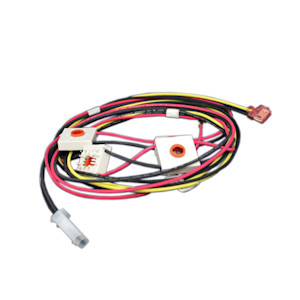
This DIY repair guide shows how to replace a spark igniter switch in a freestanding gas or dual-fuel range, but it can be adapted to a built-in range as well. If the surface burner won't spark when you turn the burner control knob to the Lite position, or if the igniter clicks constantly even when the burner is off, then replace the burner igniter switch using a manufacturer-approved replacement part.
This repair procedure covers many Kenmore, Frigidaire and Electrolux gas ranges. You also can use the same basic process to replace spark igniter switches in GE, Whirlpool, KitchenAid, Maytag, Amana, Bosch, Samsung and LG gas ranges.
Instructions
- 01.
Shut off power and gas
Pull the range away from the wall.
Unplug the power cord from the wall outlet and then close the gas supply shut-off valve.
Wear work gloves to protect your hands from sharp edges.
The cooktop and grates must be cool to the touch. You might need an assistant to help remove the cooktop.
- 02.
Remove the cooktop
Remove all the cooktop grates and then lift the gas burner caps off the burner heads. Set these parts aside.
Using a 1/4-inch nut driver, remove the screws that secure the gas burner heads in place. Remove the burner heads from the cooktop.
Remove the screws that secure the top of the cooktop to the top of the burner orifice holders.
To pop the cooktop out of the 2 mounting clips under its front edge, position a slot screwdriver or stiff putty knife between the front of the range frame and the cooktop, about 3 inches from the side of the range. Push the tool straight into the gap and lift slightly to release the clip that holds that side of the cooktop. Repeat for the other side.
Lift the front of the cooktop and then carefully remove the cooktop without disturbing the burner orifice holders. Set the cooktop aside.
Tip: Mark the burner caps with a note indicating their location (Left Front, Right Front, Left Rear, Right Rear).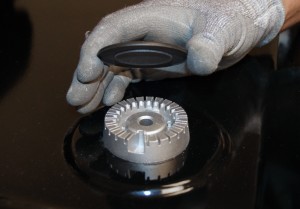
PHOTO: Remove the caps from the burners.
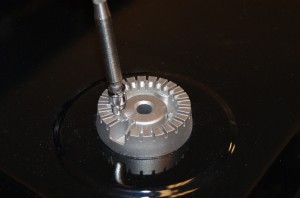
PHOTO: Remove the screw from the burner head.

PHOTO: Pull off the burner head.
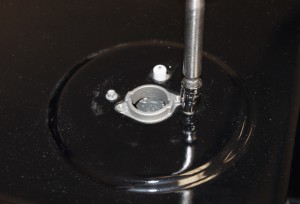
PHOTO: Remove the screws that hold down the cooktop.

PHOTO: Release the clips that hold down the front of the cooktop.
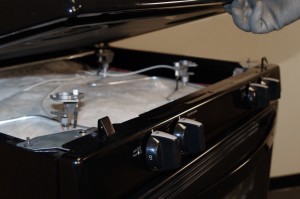
PHOTO: Lift up the front of the cooktop.
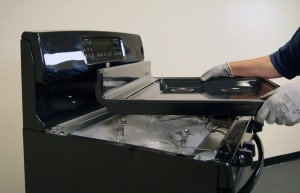
PHOTO: Pull off the cooktop.
- 03.
Remove the control manifold
Open the oven door fully and remove the screws that are under the control manifold.
Pull the control knobs straight off the stems of the gas burner control valves on the front of the control manifold.
Remove the screw that's behind each clip on top of the control manifold.
Lift the control manifold off the gas range.
Take care to not lose the mounting clips, which are loosely attached to the top of the control manifold.
Tip: You should be able to remove the screws with a Phillips screwdriver. The fastener heads vary by model.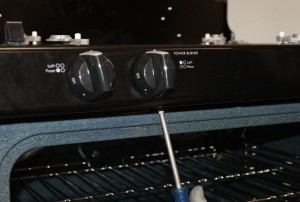
PHOTO: Remove the screws below the control manifold.
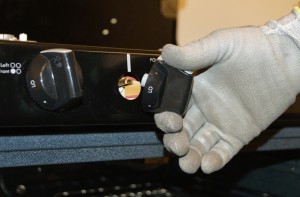
PHOTO: Pull off the burner control knobs.

PHOTO: Remove the screws behind the clips on top of the control manifold.
- 04.
Remove the spark igniter switches
Pull the spark igniter switches off the front of the burner control valve stems.
Remove screws from the upper panel on the back of the range and then pull the upper back panel off the range.
Disconnect both red wires from the spark module.
Pull the wire harness out through the front of the gas range.
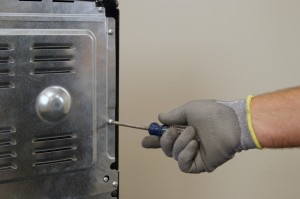
PHOTO: Remove the screws from the upper back panel.
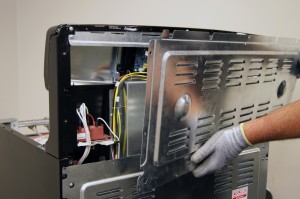
PHOTO: Remove the back panel.
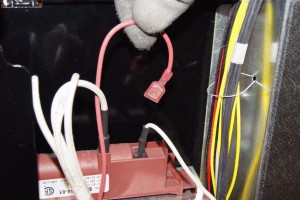
PHOTO: Disconnect the red spark module wires.
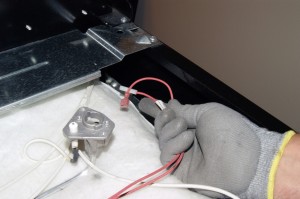
PHOTO: Pull the wire harness for the spark igniters out.
- 05.
Install the new spark igniter switches
Push the new spark igniter switches onto the front of the gas control valves, with the long tail of the wire harness on the right (as you face the range) so it can reach the spark module.
Push the wire harness through the opening on side of the frame to the back of the gas range.
Connect the wires to the spark module. One wire has a spade connector that pushes onto a spade at the top of the spark module. The other wire has a white plastic connector that plugs into the red wire below the spark module.
Position the upper back panel on the back of the range and hold in in place while inserting the first screw or two.
Insert all the screws and tighten them firmly.
- 06.
Reinstall the front control manifold
Position the control manifold on the front of the gas range.
Make sure the mounting clips are in place and then install the screws behind the mounting clips on the top of the control manifold.
With the oven door open, install the screws at the bottom of the control manifold. Tighten all the mounting screws firmly.
Position the knobs on the front of the burner control valve stems and push them down fully.
- 07.
Reinstall the cooktop
Position the cooktop on the top of the range and snap it into the mounting clips on the front lip of the range.
Insert the screws into the holes that secure the cooktop to the gas burner tube orifice holders. You may need to move the burner tube orifice holders around slightly to line up the holes and insert the screws.
Tighten all screws firmly.
Position the burner heads in the correct locations, screw them into place and tighten the screws firmly.
Cover the burner heads with the burner caps in the correct locations. Set the grates into place on the cooktop.
- 08.
Reconnect gas and power and slide the range into place
Plug the range back into the wall outlet and then open the gas supply valve.
Slide the range into position, making sure the rear foot of the range properly engages the anti-tip bracket.
Warning: The anti-tip bracket must be properly engaged so the range won't tip forward. Refer to the installation instructions for details about the anti-tip bracket.
Most common symptoms to help you fix your ranges
Choose a symptom to see related range repairs.
Main causes: power supply failure, blown thermal fuse, bad relay control board, damaged terminal block, wiring failure…
Main causes: faulty temperature sensor, electronic control board problem, control thermostat failure, weak burner ignite…
Main causes: broken broiler element, weak or broken broil burner igniter, control system failure, faulty temperature sen…
Main causes: bad bake element, broken burner igniter, control system failure, blown thermal fuse, faulty temperature sen…
Main causes: broken oven door lock assembly, wiring failure, electronic control board problem…
Main causes: food splatters, spilling food on the oven door, allowing liquid to drip through oven door vent when cleanin…
Main causes: power supply problem, control thermostat or electronic control board failure, broken element, bad burner ig…
Most common repair guides to help fix your ranges
These step-by-step repair guides will help you safely fix what’s broken on your range.

How to replace a range oven door switch
The oven door switch detects whether the oven door is closed and helps control the oven light. Replace the switch if it …
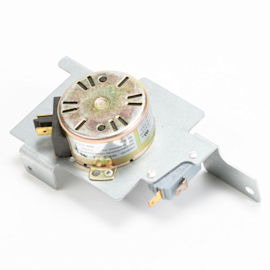
How to replace a range oven door lock assembly
Oven door not locking? You can replace the lock assembly in less than 30 minutes. Here's how.…
Effective articles & videos to help repair your ranges
Use the advice and tips in these articles and videos to get the most out of your range.

Learn how to clean and maintain your stove to keep it in top shape.…

Troubleshoot and repair problems with your range when your oven door locks shut and you can't get it open.…
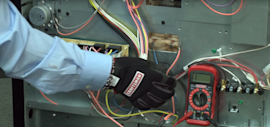
Learn how to use a multimeter to check for wiring problems in an appliance that's not working…
